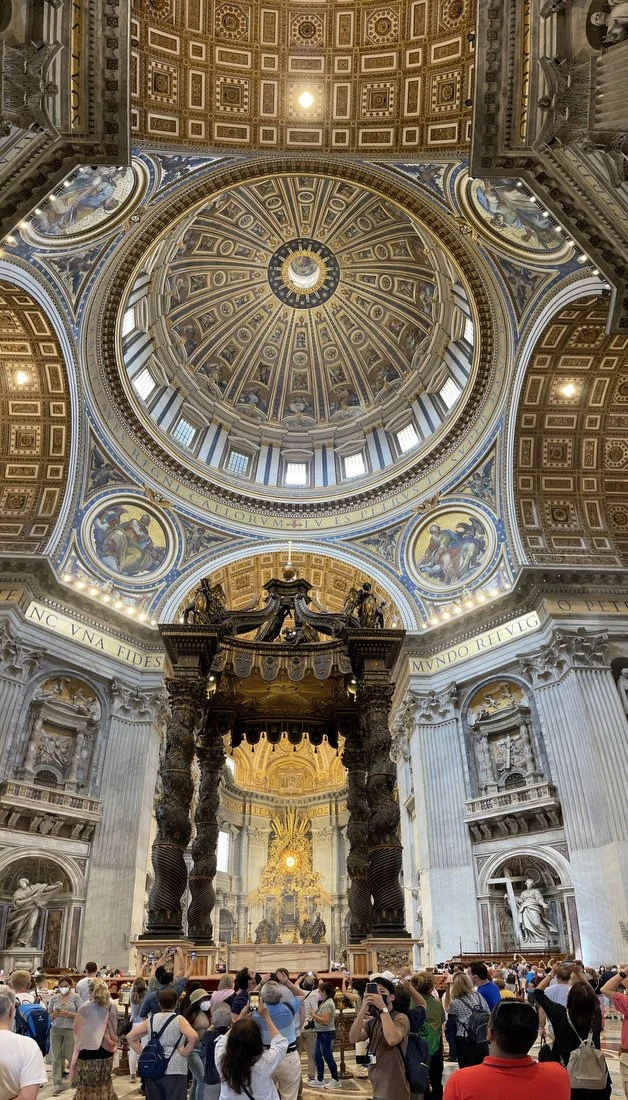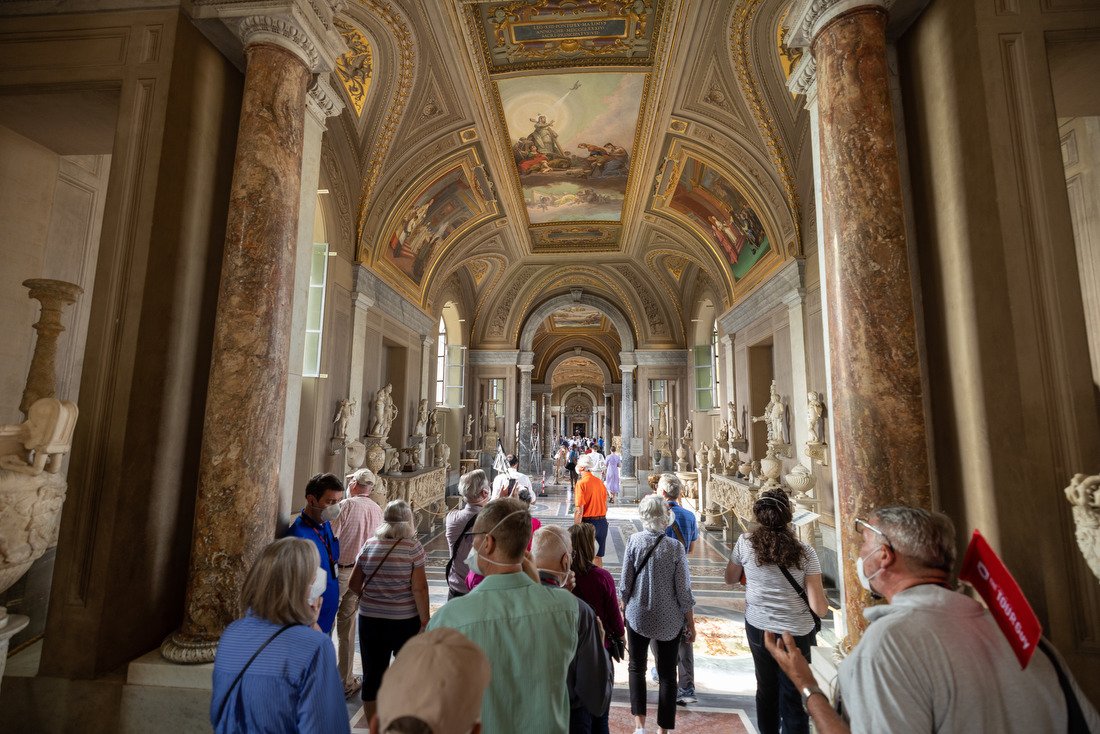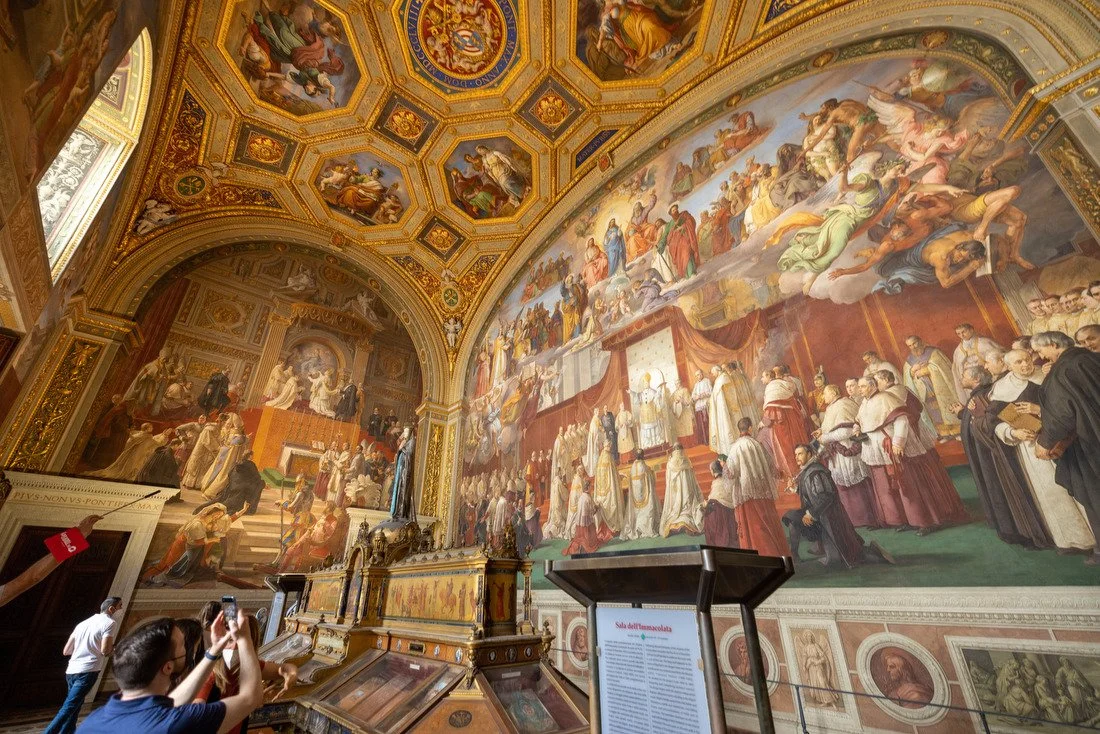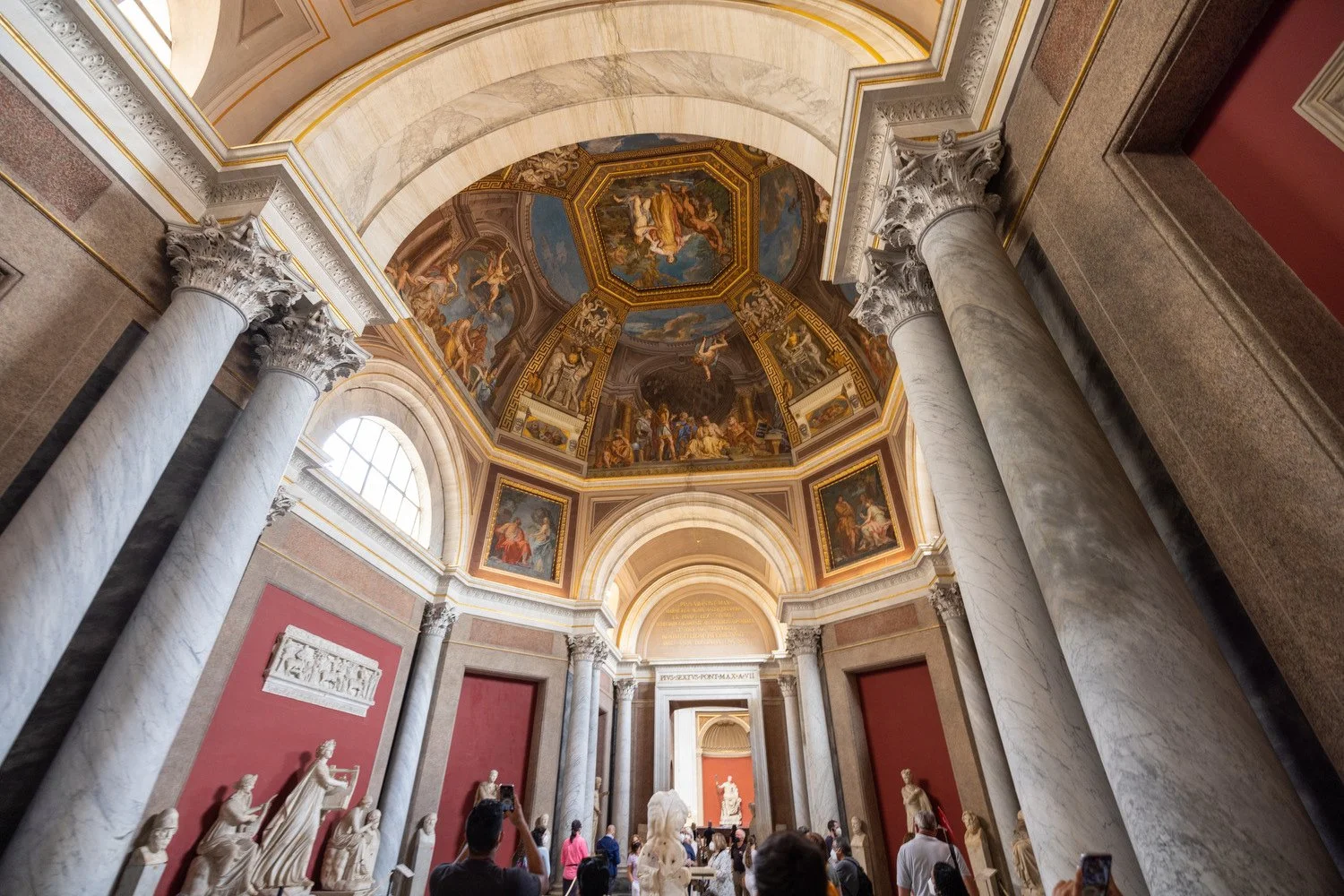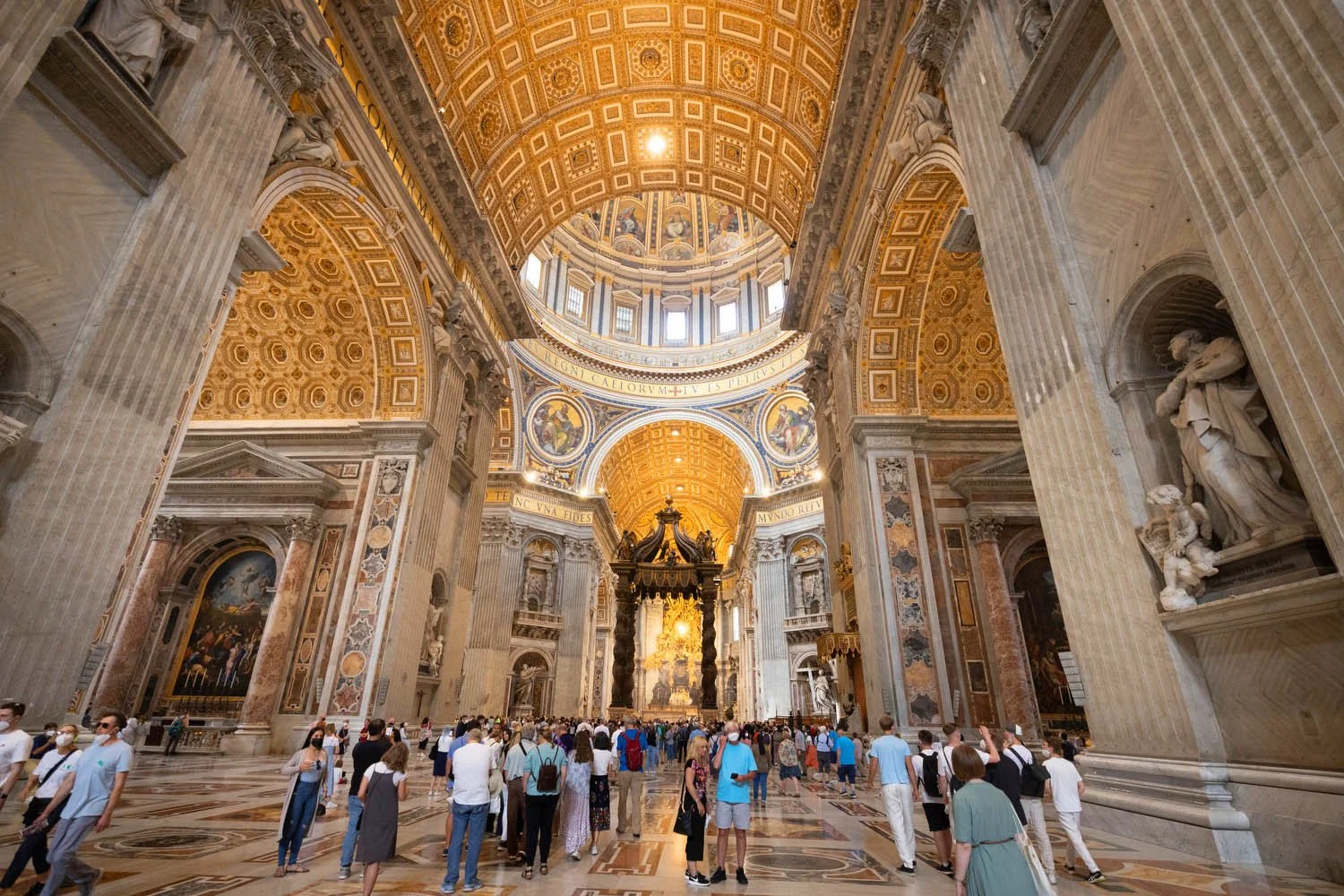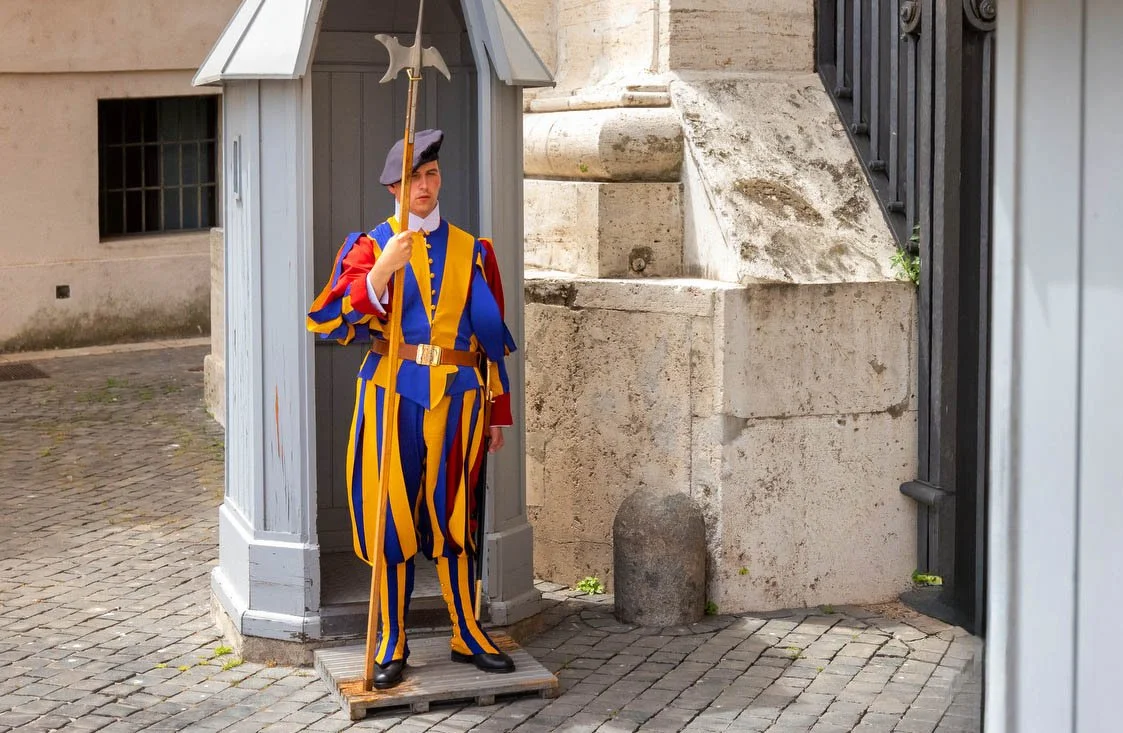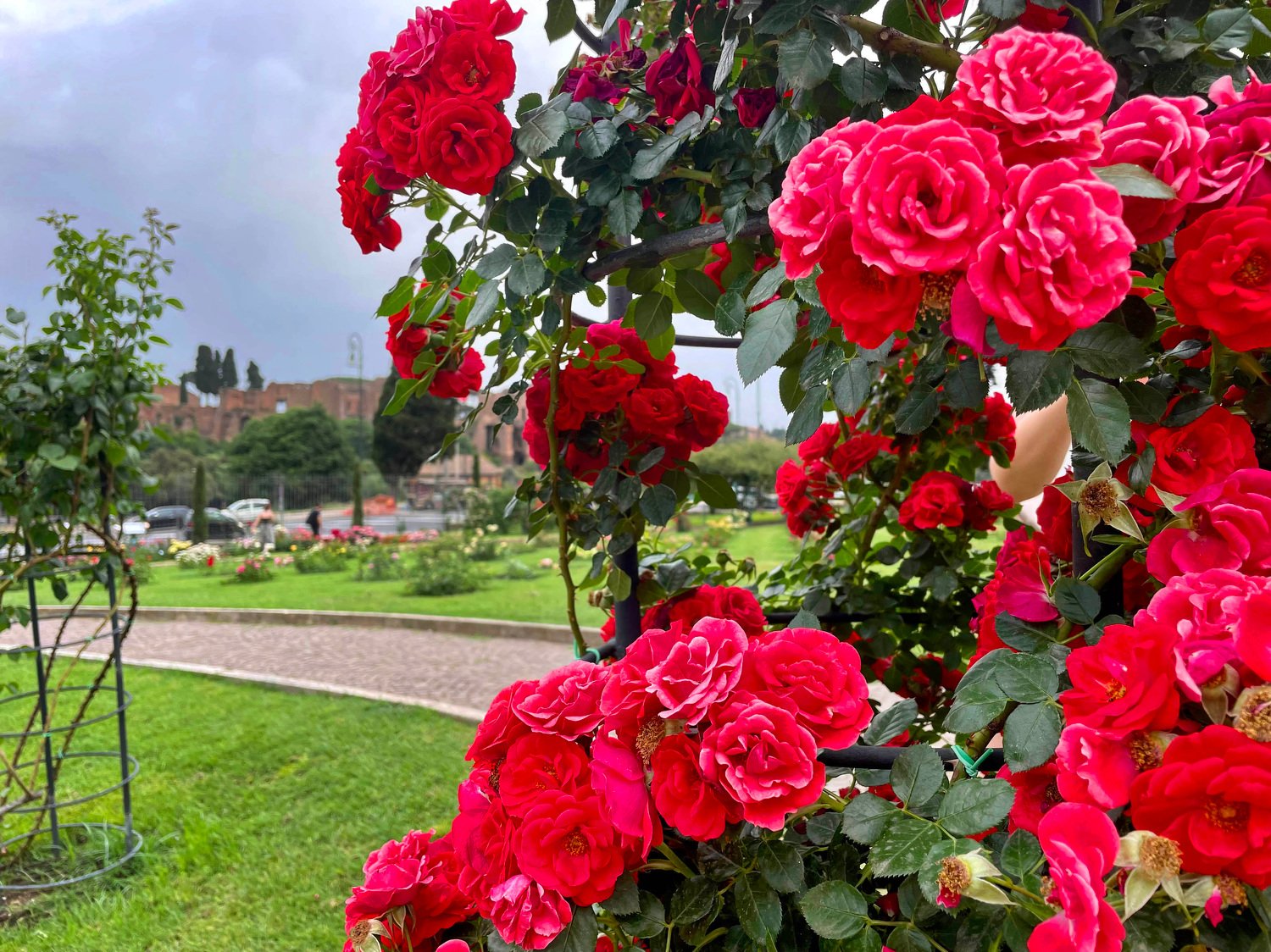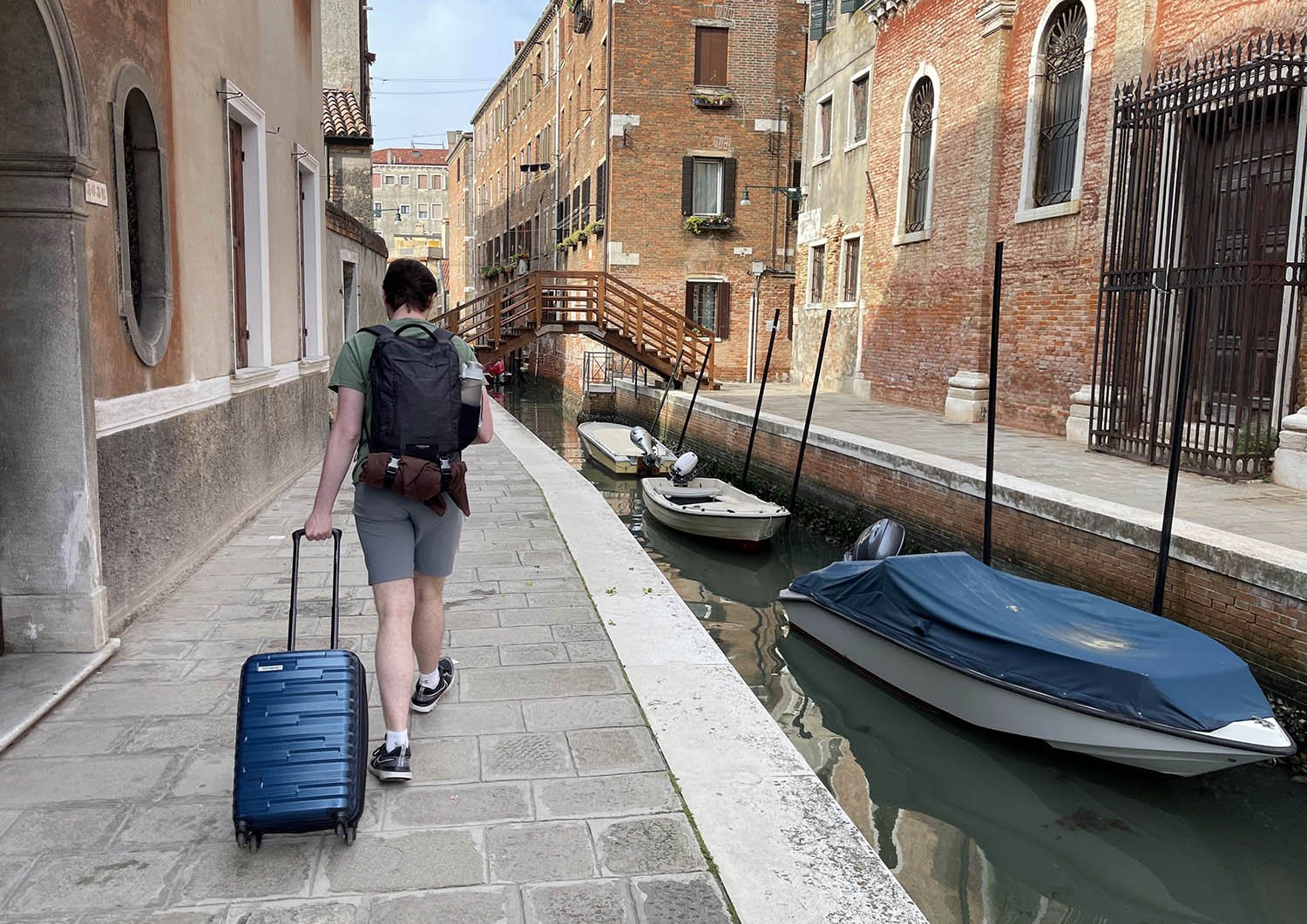Visiting the Vatican during the 2025 Jubilee year
Vatican City is a must-see for many people visiting Rome. In the Jubilee Year of 2025, 35 million religious pilgrims are expected to visit Rome and the Vatican for this celebration. The city of Rome has been busily preparing for the influx of visitors with infrastructure projects and improvements.
The home of the Pope, the Vatican is full of cultural significance and houses the largest private collection of art in the world.
St. Peter’s Basilica, The Vatican Museums and the Sistine Chapel (which is located within the Vatican Museums) are the three big attractions to see in Vatican City; all impressive sites and well worth a visit.
In this guide, we will give you some practical advice for planning your trip to the Vatican, along with thoughts on taking a guided tour, plus some impressions and takeaways from our own visits and insights as to what to expect in a Jubilee year.
Saint Peter’s Square at the Vatican. All photos by John O’Boyle / The Empty Nest Explorers
What is the Vatican’s Jubilee Year of Hope and how does that effect my visit to Vatican City?
Every 25 years (or sometimes more frequently), the Catholic Church celebrates a Jubilee Year, and 2025 will be the Jubilee Year of Hope, taking place from Dec. 24, 2024, Christmas Eve, to Jan. 6, 2026, the feast of the Epiphany.
The big event, following a 500-year-old ritual, is when Pope Francis will open the Holy Doors at St. Peter’s Basilica on Christmas Eve, December 24, 2024, ushering in the Holy Year. This is the first of five Holy Doors to be opened to celebrate the Jubilee, the sites of which are three other papal basilicas and also a yet unnamed prison, a gesture toward hope., which is the theme of this Holy Year.
The other basilicas involved are the Archbasilica of St. John Lateran, the Basilica of St. Mary Major, and the Basilica of St. Paul Outside the Walls, taking place on different dates in late December to early January 2025.
The doors at St. Peter’s Basilica are the first to be opened and the last to be closed on January 6, 2026, marking the end of the Holy Year.
This will be the 28th jubilee celebrated in the Catholic Church, coming 10 years after Pope Francis opened the extraordinary Jubilee Year of Mercy in 2015. That year, Holy Doors had been erected in basilicas and sacred sites in 40 different countries.
Inside St. Peter's Basilica.
The significance of opening the Holy Doors is that it represents a passage to receive the special grace of the Jubilee Year, where pilgrims can cross the threshold of a designated door in a designated church (most significantly, St. Peter's Basilica) to symbolically enter a new life of faith and receive a special indulgence. Such holy years are meant as a time of pilgrimage for practicing Catholics, but people outside the faith are welcome to partake in the blessings of the Holy Year.
Pilgrims interested in passing through the Holy Doors must book a time slot. Registration to book slots for pilgrimages to the Holy Doors of the four Papal Basilicas in Rome is now available through the Jubilee website. Pilgrims will be able to pass through the Holy Doors throughout the Jubilee year.
The website also includes a calendar of events, but remember the Jubilee is a religious celebration, not a secular one. So don’t expect to find listings for street fairs on there or that sort of thing. However, massive outdoor concerts were part of the last Jubilee, so it is reasonable to expect some special exhibitions, cultural experiences and concerts to be held across Rome during Jubilee 2025. Dates will be announced as events get closer.
So what does all this mean to the average visitor to Vatican City in 2025, if not specifically interested in religious activities?
Well, the biggest thing is there will be a great influx of visitors to the Vatican and to Rome in general, with an estimated 35 million religious pilgrims expected in 2025.
In order to deal with this increase of visitors, some 87 public works projects are being funded by the city of Rome in preparation for the Jubilee. Some of these projects started way back in 2022.
The plans include improvements to its public transport and public bathroom facilities, repaving of roads and the quays of the Tiber, building underground parking and pedestrian underpasses, extension of the Metro C line, and redevelopment of the platforms and shelters of Roma Termini station. If you visited Rome in 2024, you probably already saw a lot of this in action. They even have a web portal where you can track the improvement work.
Renovations to key areas in and around the Vatican will make things easier for pilgrims and non-religious visitors alike. Construction projects will transform Piazza Pia into a more pedestrian-friendly square, and this renovation will connect Castel Sant’Angelo to St. Peter’s Square.
Around and about the city center, popular sites like the Trevi Fountain are getting a makeover as well. During the cleaning process, a temporary walkway will be built around the 250-year-old fountain so that visitors can still admire the statue of Oceanus on his chariot. According to Smithsonian Magazine, there is also talk of charging a small fee to visit the site, as an attempt to manage overcrowding. This might annoy some visitors, but responsible travelers know that sensitive sites must be protected from too much love.
Trevi Fountain will be cleaned for the Jubilee Year.
These are all great things for the city! But if you are planning to visit the Vatican in 2025, be ready for lots of people!
But don’t be scared off if you’ve set your sights on visiting Rome and Vatican City in 2025. You just need to accept that it will be unusually crowded and plan accordingly. But remember that Rome is always crowded, so this is good advice anyway. Also, many pilgrims travel by tour buses and stay in large hotels outside the city center, easing some pressure on central Rome. But you will definitely want to book your hotel rooms and tickets to major attractions as soon as you can.
Tickets for the Vatican Museums and Sistine Chapel are usually released 60-90 days in advance. And these tickets will certainly sell out quickly. Even Rick Steves’ tour site says the company won’t be booking group visits to the Vatican Museums, St. Peter’s Basilica or even the Colosseum during 2025, due to “severe overcrowding, long wait times, unexpected closures, and unreliable availability for group reservations” and is advising his customers to book individual visits to these attractions. Hmm.
Recently, the city of Rome has initiated new systems that make getting in to see the Roman Colosseum and the Pantheon easier. And this was sorely needed! It is most likely that the upcoming Jubilee surge was the impetus for this change. We have some informational blog posts about both these sites and the changes - Visiting the Roman Colosseum and Visiting the Pantheon: how to buy tickets and avoid hassles.
Important things to know about visiting the Vatican
Even though Vatican City is its own country, separate from Italy, you won’t need your passport to go there.
You can visit the Vatican and stay in the surrounding area, but you can’t stay overnight within Vatican City.
Vatican City is the smallest country in the world. It became an independent city-state in 1929 and is ruled by the Pope, who is the Bishop of Rome and the head of the Catholic Church.
Vatican City is a fully functioning and contained state, with 300 residents living there. It supports its own fire and police departments, post office and a small freight railway.
The currency used in Vatican City is the euro, just like Italy. Since 2002, it has minted its own euro coins that are circulated freely throughout the entire eurozone.
Vatican City is free to enter. There is no charge to visit St. Peter’s Basilica and St. Peter’s Square. However, to see the Vatican Museums and the Sistine Chapel, there is a fee of about €20 for general admission. Costs of private tours vary, of course, depending on what you want to do.
Yes, you can get to see the Pope! Papal audiences are held on Wednesdays in St. Peter’s Square. (more details on that further below.) These are popular events and get quite crowded.
When visiting the Vatican, you must dress appropriately:
No shorts, above-the-knee skirts, or bare shoulders are permitted inside the Vatican buildings or at St. Peter’s Basilica.
Any offensive tattoo or religious symbol should not be visible
You’ll need to remove any hats or caps
Ripped jeans, t-shirts and see-through clothing are also discouraged
No low-cut or crop tops are permitted
And they really do enforce this dress code.
Tips on how to dress for the Vatican:
In warm weather, “covering up” can be a little bit of a pain. But a light colored pair of capris that covered my knees worked great for me, along with a modest short-sleeved top that didn’t show any shoulder. I packed these items specifically for the Vatican tour, but they were very multi-functional for evening or daytime wear while sightseeing or dining out. You can also carry a light scarf in your purse to cover your shoulders.
Men will have to wear long trousers, and if you have “offensive” tattoos on your arms, you’ll need long sleeves. So pack some non-jeans slacks, or at least some nice looking jeans and a shirt with appropriate sleeves (even short sleeved shirts must have enough “cover” to them - sleeveless t-shirts or “cap” type sleeves won’t be acceptable). You can’t go wrong with a button down shirt or polo. Light, multifunctional and breathable items that travel well and can be used again for a night out are best choices. Savvy travelers never waste suitcase space with “one-offs”!
While waiting on the steps outside the Museum entrance for our tour to start, we saw vendors selling large wraparound scarves that people were putting over their shorts or bare shoulders to cover up - and they were doing quite a good amount of business! So if you completely forget to dress acceptably, this might save you in a pinch. And I guess it makes a nice souvenir as well for us ladies. ;) I’ve also read that some folks bought a “paper” shawl or pair of pants for 5 or 6 euro to cover up before entering - but I did not see this for myself. It is always best to just be prepared and not count on this sort of thing.
For Papal Audiences, which generally take place outside, casual attire is fine though women are still expected to cover their shoulders and men cannot go shirtless. Hats are permitted in this outdoor setting, and you may definitely need one! Summer (even late spring) in Rome is HOT, HOT, HOT, so remember your sunblock and carry enough water. You’ll be standing in that Mediterranean sun, with no shade in sight, for quite awhile.
Why Visit the Vatican?
Being an independent state within a city, the Vatican is a very unique location; its very structure is a curiosity in many ways.
As the home of the Pope and the seat of the Catholic Church, it is of course an important spiritual touchpoint for Christians around the world. However, you don’t have to be a practicing Christian or even religious at all to appreciate the art, architecture, history and sheer splendor and influence of this very unique site.
But remember, you should always be respectful and mindful of the rules when visiting any religious location, whether you share their beliefs or not. More on that later.
We’ve toured a lot of palaces and museums in our travels, but nothing quite compares to the amount of treasure and jaw-dropping grandeur of the Vatican Museums and St. Peter’s Basilica.
The Basilica itself is simply the biggest building you can possibly imagine. And it drips with art and intricate design. The Dome of St. Peter is an architectural wonder. Likewise, standing inside the Sistine Chapel and just looking up gives one a real appreciation of the almost superhuman accomplishments of Michelangelo.
Taking a guided tour of the Vatican
A visit to Vatican City is basically a two-part affair - the Vatican Museums (which includes the Sistine Chapel) and St. Peter’s Basilica.
Each has a separate entrance ticket and its own security line. They can both easily be seen in one day, but be prepared for a lot of walking.
We think booking a reputable guided tour is really the best way to appreciate the Vatican Museums.
Here’s why:
One thing you have to realize when planning to see the Vatican is that it’s pretty much always busy. There is barely a “slow season” in Rome nowadays, and for Vatican City, there is just no such thing. (maybe in winter, but not Christmas or Epiphany week, which are just as busy as summer). Practically speaking, it’s safe to assume that there will always be a long line to get in, no matter when you go.
You can’t completely escape the crowds, but small group tours are your best workaround. With a tour, you have a meeting time and you can get right in when you are scheduled to.
Also, there is almost too much to look at in the museum galleries. The context provided by an informed guide will make the 2-hour tour much more enjoyable. There are floor to ceiling treasures to take in, and unless you are a serious art expert, you won’t really have a full appreciation of what you are looking at.
Very importantly, the only way to visit the Sistine Chapel and see Michelangelo’s famous frescoes for yourself is go through the Museum. There is no other way to visit the Chapel. It’s at the end of the journey. So even if you are only really interested in the Sistine Chapel, you will have to take the walk through the Museums anyway. So you might as well get something out of it.
Many tours will also lead you right from the Sistine Chapel (at the end of the museum tour) to St. Peter’s Basilica, (even if the “guided” part of your tour is over) so even though you will still have to go through security, you will still bypass the endless general line. Plus, this “short-cut” saves you a 20-minute walk to the Basilica.
We’ve done this both ways, with and without a tour, and it is definitely better to go the tour route. Look, we all like to think we are rugged and adventurous travelers, but there’s no need to make your life unnecessarily difficult or unpleasant. This place is just too big. Just take a guided tour!
There are MANY tours available out there, so you really have to research them a little bit and see what you want to do. Some tours include “add-ons”; some include St. Peter’s Basilica and some do not.
Here are some tour suggestions:
Vatican Museums, Sistine Chapel & St Peter’s Basilica Guided Tour
This is a great choice if you want the full guided tour experience. Link to tour page.
4 ½ stars
31,000 reviews
Tour of St Peter's Basilica with Dome Climb and Grottoes in a Small Group
This is a good choice if you don’t want to see the Vatican Museums or Sistine Chapel. Link to tour page.
4 ½ stars
1,626 reviews
Early Morning Vatican: Small Group Tour Max 6 People or Private
This option works if you’d prefer a very small tour group. Link to tour page.
5 stars
2,400 reviews
Rome: Vatican Museums and Sistine Chapel Tour with Breakfast
A fun start to your day with breakfast inside the Vatican. Link to tour page.
4 ½ stars
641 reviews
Note - This blog post contains affiliate links. This means that if we are recommending a product, activity, or hotel, we might be receiving a small commission if you buy or book from these links. This is done at no additional cost to you. We only recommend products we have personally used or have thoroughly researched.
Inside the Vatican Museums.
Recent Changes to Vatican Visitor Policy
On our last visit, we had done an “early entry” group tour of the Vatican Museum, which allowed us to get in an hour before the museum actually opened. This reduced the size of the crowd we had to deal with, though we certainly weren’t the only tour starting at that time.
In January 2024, the museum hours were changed. The Vatican Museums extended its opening hours from 8.00am until 7.00pm, as part of a major readjustment of its admission policies ahead of Jubilee 2025.
As a result, there are no more of these “pre-opening” or “after hours” group tours. Instead, the museums began opening to the general public an hour earlier and staying open an hour later than in the past, So although you can still book an early tour, is now also open to non-tour groups during these hours.
This is probably a better system overall, as it spreads the crowds out (being open more hours is generally a good thing) but this also means that more people in general can get there early.
Bottom line, this doesn't change our advice - We still suggest taking the earliest tour available in the morning for the best experience.
Since you have to dress a little nice and it’s a ton of walking, our advice would be get up early, take your pre-booked morning tour, then leave the general area to get lunch (never get lunch in tourist areas!) Afterward, go back to your hotel and take a break - especially in summer - you can change your clothes and get more comfortable, and then do something late in the afternoon.
For some more Italy traveler tips, read our post - 11 Tips for Traveling in Italy.
The Vatican is a long tour and will knock you out, though well worth it. We suggest checking out the Trastevere neighborhood in the evening for dinner. It's a quiet, relaxing neighborhood where you slow down the pace after a busy day, away from the usual bustle of Rome.
To learn more about where to eat and what to see in Trastevere, take a look at our blogpost, Trastevere: what to see in Rome’s charming neighborhood.
How to Get to Vatican City
St. Peter’s Basilica, The Vatican Museums and the Sistine Chapel are located in Vatican City, an independent state within the city of Rome. It is located on the western side of central Rome, across the Tiber River from Centro Storico (Historical Center) of Rome.
If traveling by taxi - It will take you 20 minutes (at least) from the Colosseum, the Spanish Steps or anywhere with the Centro Storico to get to St. Peter’s Square, the open area in front of the Basilica. However, the Museum entrance is actually “behind” the Vatican and this is a considerable walk.
If you think of St. Peter’s Square as the “front” of the Vatican, then the museum entrance is in the back. If you hop in a taxi and say “Vatican”, they will generally take you to St. Peter’s Square. So if going to the Museums first, you need to specifically tell the driver you want to go to the Vatican Museums entrance.
Either way, factor in some extra time, as getting around Rome by car is always somewhat unpredictable.
The most common way to get a taxi in Rome is to go to a taxi stand. A trip to the Vatican from anywhere in central Rome should cost about €20.
If traveling by metro - There are two metro stops located near the Vatican Museums entrance: Ottaviano and Cipro.
Take the A-line (orange line), going towards Battistini to get off at either Ottaviano or Cipro.
It is approximately a 5-minute walk from either station to the Vatican Museums entrance.
Public transportation tickets in Rome can be bought at vending machines in any metro station, convenience stores or newsstands. You cannot purchase them while on the train, bus or tram.
If traveling by bus - You can take bus number 64 from outside the Termini train station, to the last stop on the route, P.Za Stazione S. Pietro, about a 20-minute ride.
From P.Za Stazione S. Pietro bus station, it is about a 15-minute walk to the Vatican Museums entrance.
Alternatively, you can take the number 81 bus from outside the Colosseum.
Take the bus to the end of the route at Piazza Risorgimento.
It is about a five-minute walk to the Vatican Museums entrance from there.
Visiting the Vatican Museums.
How to visit the Vatican Museums
It is called “Vatican Museums” and not just “Museum” because the original 1506 structure has been added onto many times over the centuries. Centuries. Let that sit a minute.
The priceless art collection amassed by the Catholic Church is unmatched. There are about 2000 rooms displaying 70,000 works of art. And most of the collection isn’t even on display! This is why we recommend taking a tour. It’s pretty much impossible to take on a museum of this size without some guidance.
If you want to brave it without a tour, it is still highly recommended to book a ticket in advance.
The wait in line without a pre-booked timed ticket can literally be hours.
Book your ticket online through the Vatican Museums website.
This link will provide you with a full rundown of available ticket options.
A “full entry ticket”, day of, without online booking, is € 20
Booking in advance costs an extra € 5, but allows you to “skip the line” with a timed ticket.
The entrance to the Vatican Museums is on the north side of the museums, on Viale Vaticano.
Every visitor, pre-booked or not, needs to go through airport-style security and metal detectors. Try not to carry too much stuff with you; if your backpack is too big they will make you check it in a locker, and who knows how long a line you’ll have to wait in to retrieve it.
Vatican Museums hours for 2025
From Monday to Saturday:
- 8:00 am – 8:00 pm (final entry 6:00 pm)
The Vatican Museum is closed Sundays, except for the last Sunday of every month, when entry is free.
- 9.00 am – 02.00 pm (final entry 12.30 p.m)
This is the most crowded day for visiting the Vatican Museums.
The Vatican Museums is set up to be experienced as a one-way walking tour that begins at the Pinecone Courtyard, where you can view the dome of St. Peter’s Basilica and the ancient Bronze Pinecone that gives this courtyard its name. From there, you can follow the signs from room to room until you reach the Sistine Chapel, at the end of the journey.
Here’s an interesting fact: Michelangelo designed the steps that lead up to the Pigna (the Bronze Pinecone). A detail like that, if it were anywhere else, would be “the'' major attraction. But at the Vatican, it's just sort of a throw in. This we found to be typical of the whole Vatican experience. It’s so loaded with religious masterpieces that it’s almost impossible to give every piece its due.
Of course Michelangelo comes to mind as the prominent artist of Vatican treasures, but there are also numerous works of Rapheal, Leonardo, Caravaggio, Bernini, Perugino, and many, many others.
For that reason, we can’t possibly talk about every room or gallery within such a massive maze of a museum, but we did have some favorites.
The Hall of Statues in the Vatican Museum.
I loved the Room of Animals, and the Hall of Statues, as both featured so many exquisite sculptures, just lined up and piled in, almost as if they were in storage in some eccentric rich person’s enormous closet.
Even floors and ceilings are works of art at the Vatican. The Galleria della Candelabra illustrates this perfectly.
Most memorable to me was The Gallery of Maps with its striking and brilliantly painted golden ceiling, and maps hanging along the walls from the 1500s. It’s always interesting to me to see how past generations perceived the world. Not surprisingly, most of these maps are of Italy.
Once you exit the Gallery of Maps, you can go left to visit the Raphael Rooms before visiting the Sistine Chapel, or you can bypass that and turn right to immediately go to the Sistine Chapel. But once you’ve visited the Sistine Chapel, you cannot go back to see the Raphael Rooms.
Our tour guide suggested we bypass the Raphael Rooms, as we had already seen and discussed in depth many other Raphael works in the Pinacoteca gallery earlier in our visit.
Welcome to the Vatican, where blowing off priceless masterpieces is no big deal. ;)
But I have read that the Raphael Rooms are beautiful and really only take a few minutes to walk through.
Taking photographs is permitted in the Vatican Museums, but not in the Sistine Chapel.
The Gallery of Maps inside the Vatican Museum.
Visiting the Sistine Chapel
For many visitors, The Sistine Chapel is the reason they come to the Vatican. So it can get rather crowded, even on an early morning tour, which is really your best shot at less people.
Having been there twice, 25 years apart, I can definitely say it has gotten way more crowded. But it’s worth it. C’mon it’s been standing there for five centuries waiting for you; you can handle a few people! And you’ll be mostly looking up anyway!
Most people know that Michelangelo famously painted the ceiling of the Sistine Chapel in the early 1500s as well as the fresco on the wall behind the altar, called The Last Judgment. These are some of the most studied and important examples of Renaissance art. The other frescoes on the walls of the chapel were also painted by masters - Botticelli, Perugino, Ghirlandaio, and Rosselli. But as far as posterity is concerned, Michelangelo has upstaged them all.
At the time when he was commissioned to paint the ceiling, Michelangelo was a sculptor with no real experience painting frescoes. It took him four years to complete the ceiling and the task was so tortuous that he wrote a tongue-in-cheek poem about his misery doing the job. I find that funny because I tend to assume these celebrated religious artists were always in some kind of spiritual rapture zone as they created their masterpieces. Not necessarily so! They were working artists for the most part, and often did religious pieces because the church tended to have enough money to commission ambitious projects.
Michelangelo’s frescoes on the ceiling depict the story of the Creation, Adam and Eve, and Noah and the Flood.
The Sistine Chapel is not just a museum though. It is a chapel, and it plays an important role in the Catholic tradition, as the place where the cardinals of the church gather in conclave to elect the new Pope.
The cardinals vote in several rounds, burning the “ballots” after each vote. When a new Pope is being elected, crowds of the faithful wait eagerly in St Peter’s Square to see what color smoke will emerge from the Chapel. If it is black smoke, it means that the cardinals have not yet elected the Pope. White smoke means a new successor has been chosen, and of course is a cause for great excitement among the crowd.
The Sistine Chapel has played this important role in the business of the church for centuries. (Can you imagine having your business conference in a setting like that?)
So bear in mind, the Sistine Chapel is considered a holy place, and it should be respected as such. No photos are allowed, and you are asked to keep silent while inside the Chapel.
Just as a personal takeaway, I was pretty shocked the most recent time I went there how incredibly disrespectful the crowd was inside the Chapel. They were taking photos with their phones - although photos are prohibited; talking out loud in normal voices - although signs are everywhere asking visitors to remain silent and tour guides and museum personnel stress this before you go in. Honestly, all I could think was - what is wrong with you people???? Did your mama raise you in a barn???
Please folks, let’s all take a pledge to be mindful guests of the places we visit, and not be ugly tourists. If you aren’t going to be respectful, please stay home and don’t spoil the experience for other people.
How to tour St. Peter’s Basilica
We suggest going through the Vatican Museums and seeing the Sistine Chapel first, then going to see St. Peter’s Basilica.
Alternatively, if you are not taking in the Museums that day, you can just go to the Basilica separately.
As mentioned above, pilgrimages through the Holy Doors at St. Peter’s Basilica during Jublilee 2025 have to be booked separately through the Jubilee website.
The Basilica is free to enter and just like visiting any other very famous church. You will have to wait in line and go through security, and comply with the dress code as described above. If going on your own, go as early as possible as the lines get really long.
You can also book a guided tour just of St. Peter’s Basilica only; but it’s pretty easy to self-tour. It absorbs large crowds easily so it’s pretty easy to move around. There is also an audio guide available.
St. Peter’s Basilica is open everyday from 7am to 7:10pm. It is closed on Wednesday mornings, when the Pope holds his papal audiences. The audiences attract big crowds, so unless you would particularly like to see him, it’s probably best to avoid Wednesdays in general, as many people will want to visit the Basilica afterward when it opens.
Just inside, you will immediately see Michelangelo’s Pieta, one of the most beloved and celebrated sculptures in the world. It’s a personal favorite of mine - well, I suppose most people feel this way, as it is quite beautiful. But on a personal note, I will always remember my sister telling me her impressions of seeing it at the New York World’s Fair in 1964. She was just a little girl and I was too young to go with her, but the dramatic blue lighting on it as she traveled past it on an escalator impressed her for life. She told her story so beautifully to me that it has become part of me. Great works of art can touch you personally sometimes in unexpected ways. And can you imagine what a BIG DEAL it was to pack the Pieta off for travel to the US???
Back to the present, the Pieta does not disappoint; it’s only too bad that it is so high up and is encased in glass. This is because the statue was attacked with a hammer and badly damaged in the 1970s. But it has been fastidiously restored and looks perfect now. Though I wish you could see it at eye level. And no groovy 1964 blue lights, of course.
St. Peter’s Basilica is the tallest building in Rome. The sheer size of the interior space is jaw-dropping. It’s like going to church in the biggest empty train station in Europe - only one that is exquisitely decorated. Many of the artworks are mosaic replicas of the famous masterpieces that are housed inside the Vatican Museums.
The Dome of St. Peter was designed by Michelangelo and is an architectural marvel. It is the last project he worked on before his death and is decorated with stunning mosaics.. It is the tallest dome in the world, rising to a total height of 136.57 meters (448.1 ft) from the floor of the basilica to the top of the external cross.
You can go up into Michelangelo's dome. It’s free and offers great views both inside and out. Visitors can either walk the 231 steps or take the elevator to the first level, where they can go out onto the roof, behind the statues of Jesus and the Apostles.
For further adventuring, visitors can climb an additional 320 to the cupola. These steps become progressively narrower and more winding, ending in a tight, corkscrew staircase. This may not be for the claustrophobic, and there is no elevator option for this part of the climb.
But the bird’s eye view from the top of the cupola of Vatican City as well as greater Rome makes it well worth the climb, if one is physically able. Of course this is a popular thing to do, so it can be crowded. Best time to do it is early in the morning.
The Dome is open from 7:30am to 6:00pm.
Also very interesting to see is the Vatican Grottoes. These are the tombs of a number of popes, which are located one level down. It’s easily accessible and quite an open space, not dark or scary.
(This is not to be confused with the Tomb of St. Peter, who is buried beneath the main altar and can only be visited by limited specially arranged tours.)
It is a church, so be mindful that Mass or other religious celebrations could be going on, so be respectful. Unlike your “average” church, St. Peter's Basilica has many altars and masses are conducted across them.
The Swiss Guard on duty at the Vatican.
How to see the Pope at the Vatican
If seeing the Pope is something you’d like to try to do, you can attend a general audience.
Every Wednesday morning, if the Pope is in town, he holds an audience for the general public in St. Peter’s Square, starting at 9:30 am. St. Peter’s Basilica does not open until 12:30 pm on these days after the audience is over.
In addition to the usual Wednesday audiences, the Pope will hold audiences on Saturdays in 2025 when no major events are scheduled. This addition provides more opportunities for pilgrims and visitors to attend a papal audience during Jubilee 2025.
You don’t need a ticket to attend a general audience. These are free public events. But they do draw big crowds, so you might want to come early.
Don’t fall prey to anyone trying to sell you a ticket for better access. That’s probably a scam.
As always, our best advice is to only trust reputable tour operators, like Viator or Get Your Guide.
Many years ago on our first trip to Rome, we just “showed up” at the Vatican rather haphazardly, not knowing that we were walking into the beatification ceremony for Padre Pio. For Catholics, beatification is one step away from sainthood, and as Padre Pio was Italian, well it was a pretty big deal for the locals.
This was pre-internet, so we had absolutely no idea what was happening as we approached St. Peter’s Square. We turned a corner and saw it was packed with the largest sea of people we had ever witnessed.
Needless to say, we had to come back another day to visit the Museums and the Basilica, (and wait in line) but it was quite a memorable experience, and we still talk about it 25 years later and laugh at our inexperienced traveler ways!
Mailing postcards from the Vatican
Some people find it fun to send postcards or other mail from Vatican City with a Vatican stamp, and get a Vatican postmark and save it as a souvenir.
Did you know - The Vatican postal system was established in 1929 and has a reputation of being one of the most efficient postal systems in the world. Anyone can send mail both inside and outside Vatican City, just make sure you use the yellow post box for Vatican mail and not a red post box for Italian mail.
The sale of postage stamps is one of the things that support the unique economy of Vatican City. It is primarily supported financially by donations from the faithful, but the sale of things like stamps, souvenirs and museum admission fees also support the city.
You can buy Holy See postage stamps at the post office or at museum gift shops.
Vatican City has no taxes and items are duty-free.
The official Vatican post office that is open to everyone is located under the colonnade to the right-hand side of St Peter's Square, open Monday to Saturday from 8:30 am until 6:30 pm.
The central Vatican post office inside the gates of S. Anna is reserved for Vatican employees.
And on that note, we hope this extended Postcard from the Vatican helps you plan your trip to Vatican City!!! ;)
This post was researched and written by Debbie of the Empty Nest Explorers. You can learn more about the Empty Nest Explorers here.


